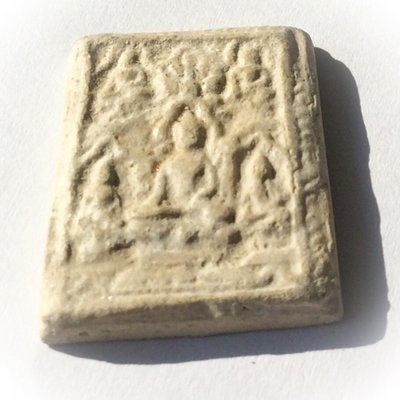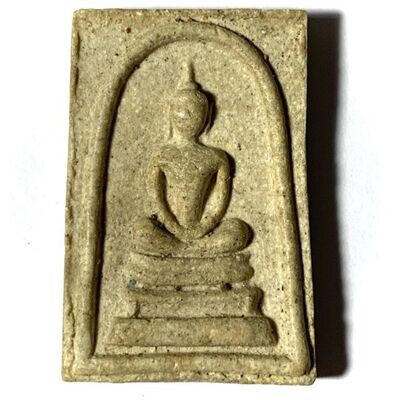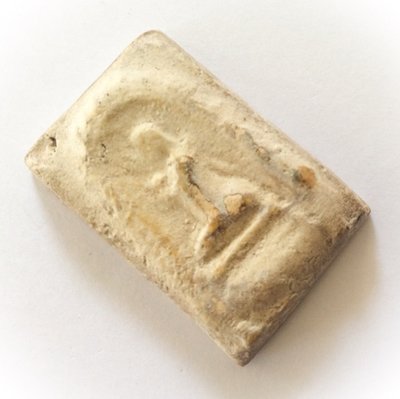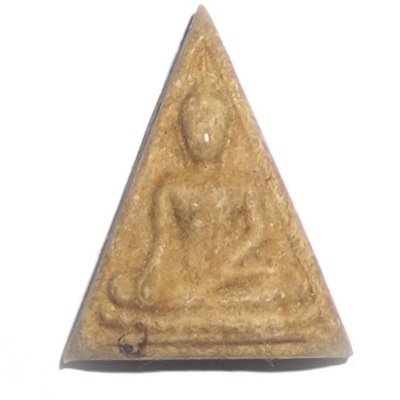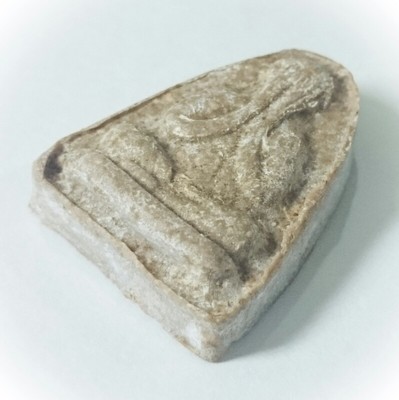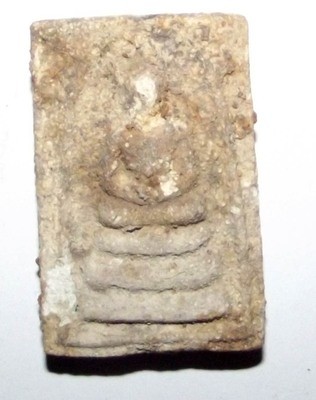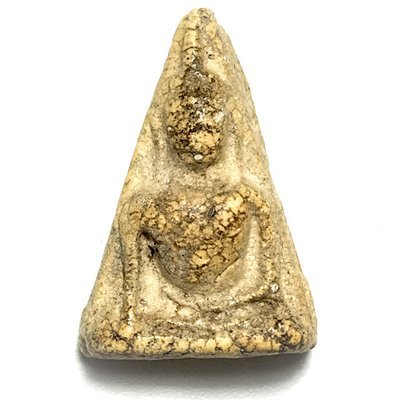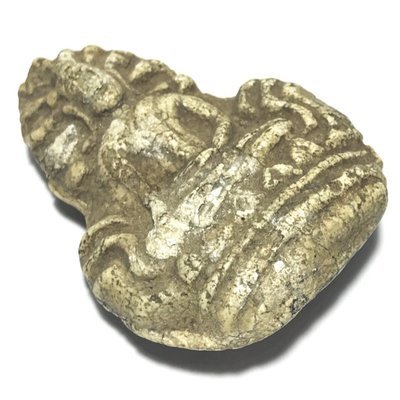A pristinely kept and extremely rare Rian Mangorn Koo Nuea Nava Loha Pim Pised Dtok Sorng Code Ma Wat Pha Nong Lom Run Sao Ha Maha Sethee 5th Lunar Saturday Blessing Ceremony Edition Guru Monk Coin, released in 2543 BE, to raise funds for the Kuti Songk Monks Huts and improve the facilities at the temple of Wat Pha Nong Lom.
This model of Rian Mangorn Koo twin dragons Monk Coin is a very rare Pim Pised (Niyom preferred) and differs from the majority of Rian Mangorn Koo Wat Pha Nong Lom Edition coins in Nava Loha, because of the double code MA stamp. Most coins of the Nava Loha series made for Wat Pha Nong Lom have only a single code Ma Stamp (on the Sangkati chest sash of the robe of Luang Phu), and only the Pim Pised special models received double code stamps. Only very few (unknown number) were distributed with double code stamp, making this not only a sacred, powerful master class amulet, but also a rare collectors piece.
The Rian Mangorn Koo of Luang Phu Hmun is, as are all of his amulets, known for the power of Jaroen Lap Wealth Increasement, and Lucky Fortunes, as well as for their Miraculous Protective Powers. Those born in the year of the dragon love to Bucha this amulet especially, for the obvious reason of the double dragon guardians.
For those with lower budgets, who seek power above collectability and rarity, we recommend to seek the Rian Mangorn Nuea Tong Daeng or Nava Loha single Code Ma, of the same edition, which carries a lower price than this special Nava Loha Pim Pised Gammagarn double code collectors edition model.
Indra God on 3 headed Elephant Steed Lopburi Era Art - 11.5 x 6 Cm Plaque - Nuea Chin Boran Ancient Sacred Artifact from 100 Year Old Archeological Dig
This is a truly exquisite sacred Leaden Artifact made from Nuea Chin Alchemical Leaden Muan sarn Substance, which was dug up in an Archeological Dig in the Temple Grounds of a North eastern Region temple around 100 years ago. The actual exact age of the artifact istelf is unknown.
It was buried in a Kru Hiding Place along with a host of other artifacts. This is a common practice performed by Guru Masters to preserve Buddhist Artifacts and ensure the knowledge of the existence of the Buddhist Religion, by hiding artifacts so that they are found by future generations, as a way of letting people in the future know that there was once a time when the Buddhist faith was in its Heyday in the region.

Apart from it being of course an extremely collectible historical artifact, it is essentialy a Sacred and Powerful Bucha for reverence and prayer, and is empowered by the Olden days Masters who made it, in the classic Lopburi Era style of Thai Buddhist Art.n A predominantly Khmer Influenced style is evident, as is Ubiquitous in the lopburi style of Buddhist Sacred Art, depicting the God Indra sitting on the 33,333 Headed Erawan elephant.

Erawan is depicted with a simplified triple headed form, but in truth is according to legend known to possess thirty three heads, and in its fullest extension in some legends, a total of thirty three thousand, three hundred and thirty three heads.

Erawan is is the steed of the God Indra of the Dawadeungsa Celestial Heaven.
Kata Bucha Pra Intr - Prayer to Beseech Blessings from Indra
Om Dtrajara Intra Mwidtaara Mintrang Hawae Hawae Suhawae
Surintram Manyaami Sakrabparuhudt Intram Sawasidt Taadtawintrach Om Intraaya Manach
Version 2
Om Namo Mahaa Intra Chakrakho Arahang Putto Na Mo Puttaaya Na Ma Pa Ta Ja Pa Ga Sa Sa Bpa I Bpi Idti Arahang Mahaa Dtrai Lokang Puttang Mahaa taewang Bprasittimae
The Daewadeungsa Realm is the next realm lying above the Jadtu Maha Rachiga. It is 336 Million Wa higher, and is on the peaks of Mount Meru (Pra Sumen). It is the Domain of Indra. It is 8 Million Wa in width, with a City called Trai Dtreungs.
This City has a thousand gates, and a crystal wall around it. Each gate has a a crystal diamond palace on its spires. When any of the gates open or close, they make a beautiful sound like music. There is a castle in the center with nine crystal forms which is 256 Million Wa high.

• In the Eastern quarter, there is a Divine Heavenly Garden, called Nantrawan, or, 'Nipaawan' 800,000 Wa in diameter and the gate has a Crystal Palace and with Immense Majestic Park within it. It is filled with Divine treasures, beautiful fruit trees and flowers in bloom. There is a large Lake called Nantaa Bogkhorani with crystal clear blue water with two crystal pillars called 'Nantabaditipasan', and 'Julanantaabaditipasan'. All is soft to the touch, with a smooth and silky surface. There is a large Forest called Maha Pon, with a golden wall surrounding it. Likewise, the Gates of this Kingdom are topped with Crystal Gem Palaces, and is 500 Thousand Wa in diameter. There is a Golden Palace within it and two Parks called Suan Mahawan and Suan Nantawan. A Crystal Dolmen with a Crystal parasol above it.


• In the South, there is a Great Park called 'Parusakawan', 5,600 Thousand Wa in diameter the gate has a Crystal Palace and with Immense Majestic Park within it. Above this Gate is a Crystal palace. Within it, is a double Lake, called Patrabogkhorani and Supatrabogkhorani – next to this were two glass like stones, named exactly the same. The stones are very smooth and soft.

• To the West of this Realm, is the Jidtraladawan Park with a diameter of 400,000 Wa. This Quarter of the Realm houses also two lakes, Jidtralada Bogkhorani and Julajidtraladabogkhorani with a crystal monolith, called Jidtra Pasan.

• In the Northern Quarter, there is an Immense Park full of beautiful trees and flowers, also with Gates and Palaces above each gate. This area is 50 Thousand Wa in diameter. There are also two large lakes, one called Tamma Bogkhorani, and the other called Sutamma Bogkhorani. The two monoliths of crystal are called Tammaa Bpadtitipasan, and Sutamma Bpadtipasan
A Golden Throne is pulled by a Golden Horse, with pearl and flower garlands. When the wind blows the sound of the Conch, Drum, Vina and Flute can be heard from the Devas playing in the Sky.

On Pra Sumen (Mount Meru), there is an Elephant which is the Vehicle of Pra Intr (Indra). This Elephant is called Erawan. Erawan is 1 Million 200 Thousand Wa high, and has 33 heads.
When Pra Intr rides upon his steed, the Erawan Elephant swells up and grows in size becoming even more immense. A host of Nang Fa devas (female Angels) are dancing and singing around Erawan and Pra Intr (Indra).
The thirty three heads of the elephant possess Two Hundred and Thirty One Tusks, and One Thousand Six Hundred and Seventeen Lakes on them.
The Lakes have Eleven Thousand Three Hundred and Thirteen Lotus Patches With Seventy Three Thousand, Two Hundred and Thirty Three Lotus flowers in them.
The flowers possess Five Hundred and Fifty Five Thousand, Six Hundred and Thirty One petals. The Nang Fa Deities who are dancing and singing around Pra Intr, are One Million Eight Hundred and Eighty Two Thousand, Five Hundred and Seventeen Devas in total.

Erawan is featured in the Ramakian Epic Myth (Thai Ramayana), and is killed by Hanuman who breaks his neck in the fight against Intarachit, a soldier of the Asura Giant (Yaksa), the Twenty Headed Totsagan.
Intarachit throws himself into a fury rage and transforms into Pra Intr riding on Erawan and shoots his special weapon the Prohmamas arrow, which hits Hanuman after breaking Erawans neck, and Hanuman falls to the ground and into a slumber.
The Wonders of Dawadeungsa Heaven
In the Dawadeungsa Realm, there are various Amazing Legends, for example, there is a Lake with the Pra Julamani Chedi, with a Bparichadta Flower, which blooms only once every Hundred Years. When the tree flowers, the bloom glows with a bright aura of light which reaches as far as Eight Hundred Thousand Wa into the distance.
The Dawadeungsa Realm, also called Trai Treungs, or Dawatingsa Bhumi, gets its name from the fact that it is the Residence of 33 different Powers, or Deva Lords, who are ruled by Pra Amarintratirach (Pra Intr). Notice the parallel between the 33 heads of Erawan and the 33 Deva Lords under the Rule of Pra Intr.
The Name Dawatingsa Bhumi (pronounced 'Dtaawa Dtingsaa Poom' in Thai), means 'The Land of the 33 Deities'. These 33 represent Pra Intr himself, and 32 of his Companions. The legend tells that, as Pra Intr was still born on Earth as a Brahman called Makamanop, he invited 32 of his colleagues to join him in Meritorious accumulation of good deeds. They built public refuges, roads, and thiings which were of benefit to the people. They practiced the 'Sadtabpathaanawadtr', or, seven forms of regular practices;
1. Care for and treat ones parents with respect
2. Do not disrespect the Older Generation in the Household 3. Speak kind and politely
4. Do not speak hurtfully to, or be critical of others.
5. Do not complain often
6. Be Honest and Trustworthy always
7. Control one's own anger
Makamanop spent his life doing good deeds and keeping these Moral Virtues intact, and when he died, he reincarnated in the Dawadeungsa Heaven. In this heaven, there were in fact already some Angelic Beings existent (called the Naewasika Taepabudtr), who saw the arrival of Makamanop and his entourage of 32 friends, and brought a large container of Kantabala nectar to drink, offering half of it to Makananop in greeting.

But Makananop did not desire to drink any, because this nectar had an intoxicating effect , so he told his people to not drink any. So then the Angels who had already lived in this Realm, began to drink all of the nectar themselves. They soon became very intoxicated and lost their common sense and became very obnoxious, so Makamanop grabbed them all and flung them down from the Dawadeungsa Realm, because he did not wish to live with them.
He then declared himself as Lord of the Realm and ruled over his entourage of thirty two Devas. This was when he received the name of Somdej Pra Amarintaratirach (The Lord with 32 Companions). This is also the Meaning of the word 'Dawadeungsa', namely 'The Heaven that is the Home of the 33 Devas'.
